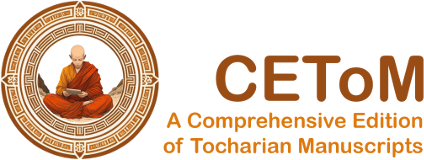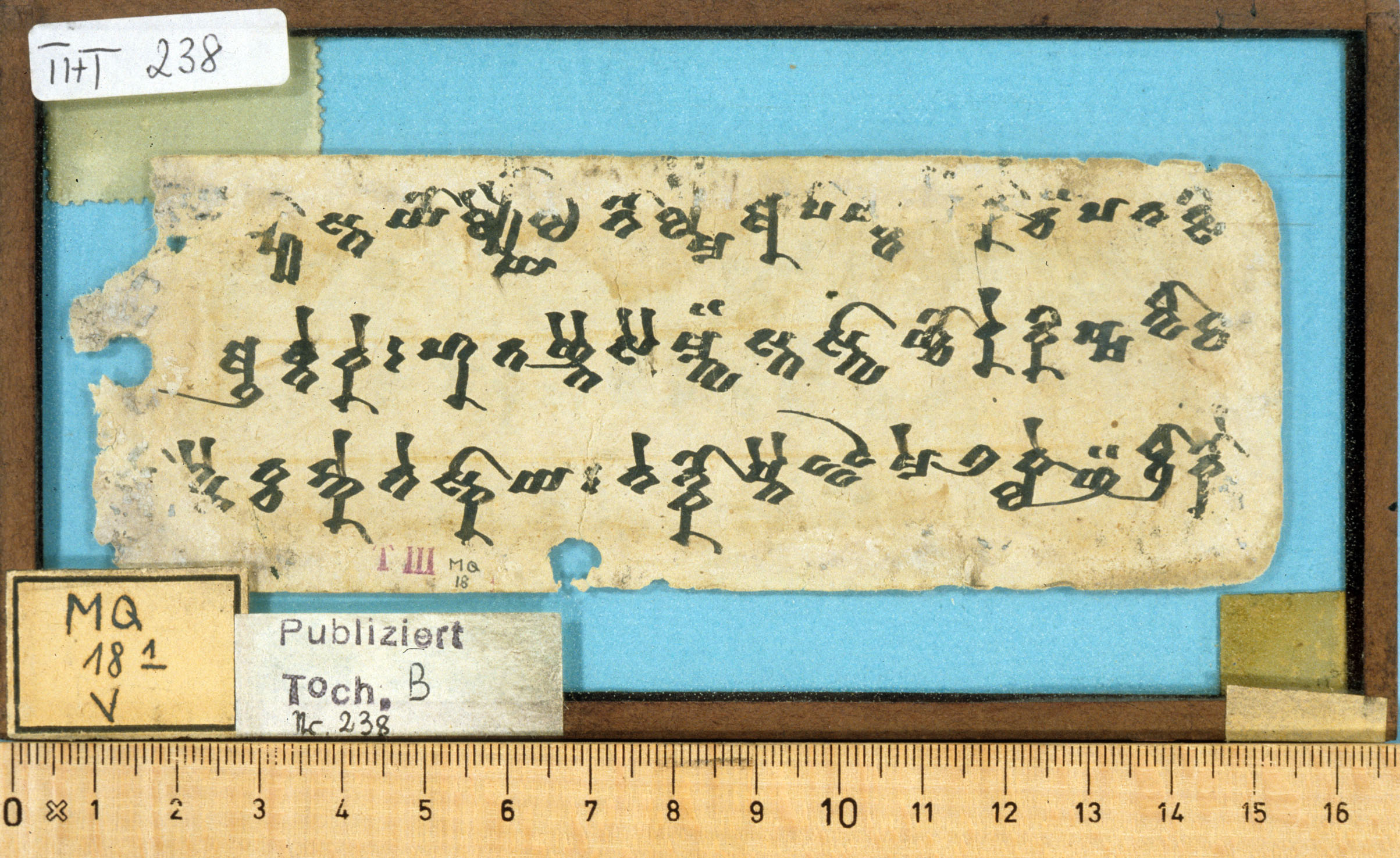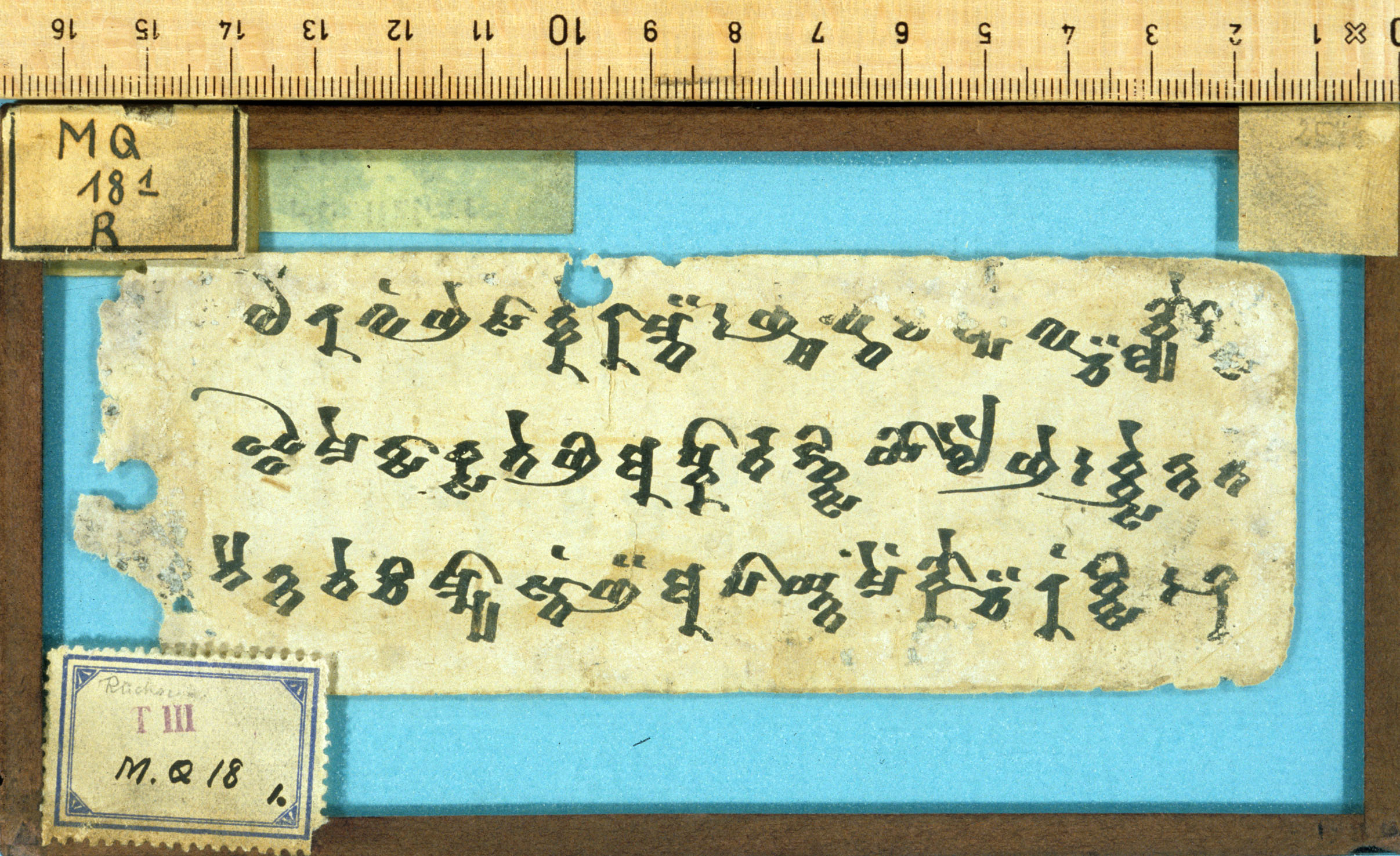THT 238
| Known as: | THT 238; B 238; Bleistiftnummer 2546 |
|---|---|
| Cite this page as: | Adrian Musitz (translation). "THT 238". In A Comprehensive Edition of Tocharian Manuscripts (CEToM). Created and maintained by Melanie Malzahn, Martin Braun, Hannes A. Fellner, and Bernhard Koller. https://cetom.univie.ac.at/?m-tht238 (accessed 17 Jul. 2025). |
Edition | |
| Editor: | Adrian Musitz (translation) |
Provenience | |
| Main find spot: | Kizil Ming-öy |
| Expedition code: | T III MQ 18.1 |
| Collection: | Berlin Turfan Collection |
Language and Script | |
| Language: | TB |
| Linguistic stage: | classical |
| Add. linguistic characteristics: | hypercorrect |
| Script: | classical |
Text contents | |
| Text genre: | Literary |
| Text subgenre: | Buddhastotra |
| Verse/Prose: | verse |
Object | |
| Manuscript: | THT 237-238 |
| Material: | ink on paper |
| Form: | Poṭhī |
| Number of lines: | 3 |
Images
Images from idp.bl.uk by courtesy of the International Dunhuang Project, the Berlin-Brandenburgische Akademie der Wissenschaften, and the Staatsbibliothek zu Berlin – Orientabteilung.
Transliteration
| a1 | /// [m]py[ā] sta yo lyyai o no lme[ṃ] a pā ynta [meṃ] k[au]¯ ¯cä pa na tsi |
|---|---|
| a2 | /// ā kte ke : 8 ta ñnai sai mwä sta swā ñco re ki ṣṣa wī ka |
| a3 | /// w[n]ai kca ṅke te skā ya : ne nko ṣnai ī me la kle¯ ¯ñä trī kau |
| b1 | /// o nu waṃ ñe sāṃ tke ra¯ ¯mtä : ñ[e]¯ ¯m wa¯ ¯t [ka] [lp]· wa¯ ¯cä klyau [ṣts]i |
| b2 | /// ī me tsā ksa te ñi a ṣkā rta ṅktsi yo lai ñe : kuse nta ta |
| b3 | /// nai nta te ci mpyā staṃ¯ ¯ñä a pā ynta meṃ kau¯ ¯cä raṃ ktsi : 9 |
Transcription
| a1 | /// mpyāsta yolyyai onolmeṃ apāyntameṃ kauc panatsi |
|---|---|
| a2 | /// ākteke : 8 tañ nai saim wästa swāñco rekiṣṣa wīkä |
| a3 | /// w nai kca ṅke te skāya : nenkoṣ nai īme läkleñ trīkau |
| b1 | /// onuwaṃñe sāṃtke ramt : ñem wat kälp(ā)wa-c klyauṣtsi |
| b2 | /// īme tsāksate ñi aṣkār taṅktsi yolaiñe : kuse nta ta |
| b3 | /// naintate cimpyāsta-ṃñ apāyntameṃ kauc raṃktsi : 9 |
Translation
| a1 | ... you (managed) to pull beings up from evil... and from bad births... |
|---|---|
| a2 | ... wonderful... |
| a2+ | The ray of your speech, oh refuge and protection, disperses (the darkness of ignorance?)... |
| a3 | ... he then made an attempt to do this... |
| b1 | Having lost their mind, confused because of suffering... ... or like a medicine of immortality, I managed to hear your name |
| b2 | ... illuminated my mind to hold back evil, which... |
| b3 | ... you managed to raise me up from the bad births... |
Other
| b2 | ... die smṛti leuchtete mir, das Böse zurückzuhalten. (Schmidt 1974: 119) |
|---|
References
Online access
Edition
Translations
Schmidt 1974: b2 (119); Thomas 1954: b2 (749); Thomas 1957: a1 (176), b3 (176)
Bibliography
“The International Dunhuang Project: The Silk Road Online.” n.d. http://idp.bl.uk.
Schmidt, Klaus T. 1974. “Die Gebrauchsweisen des Mediums im Tocharischen.” PhD, Universität Göttingen.
Sieg, Emil, and Wilhelm Siegling. 1953. Tocharische Sprachreste. Sprache B, Heft 2. Fragmente Nr. 71-633. Edited by Werner Thomas. Göttingen: Vandenhoeck & Ruprecht.
Thomas, Werner. 1954. “Die Infinitive im Tocharischen.” In Asiatica. Festschrift Friedrich Weller. Zum 65. Geburtstag, gewidmet von seinen Freunden, Kollegen und Schülern, edited by Johannes Schubert and Ulrich Schneider, 701–64. Leipzig: Harrassowitz.
Thomas, Werner. 1957. Der Gebrauch der Vergangenheitstempora im Tocharischen. Wiesbaden: Harrassowitz.
Gippert, Jost, Katharina Kupfer, Christiane Schaefer, and Tatsushi Tamai. n.d. “Thesaurus Indogermanischer Text- und Sprachmaterialien (TITUS): Tocharian Manuscripts from the Berlin Turfan Collection.” http://titus.fkidg1.uni-frankfurt.de/texte/tocharic/thtframe.htm.




